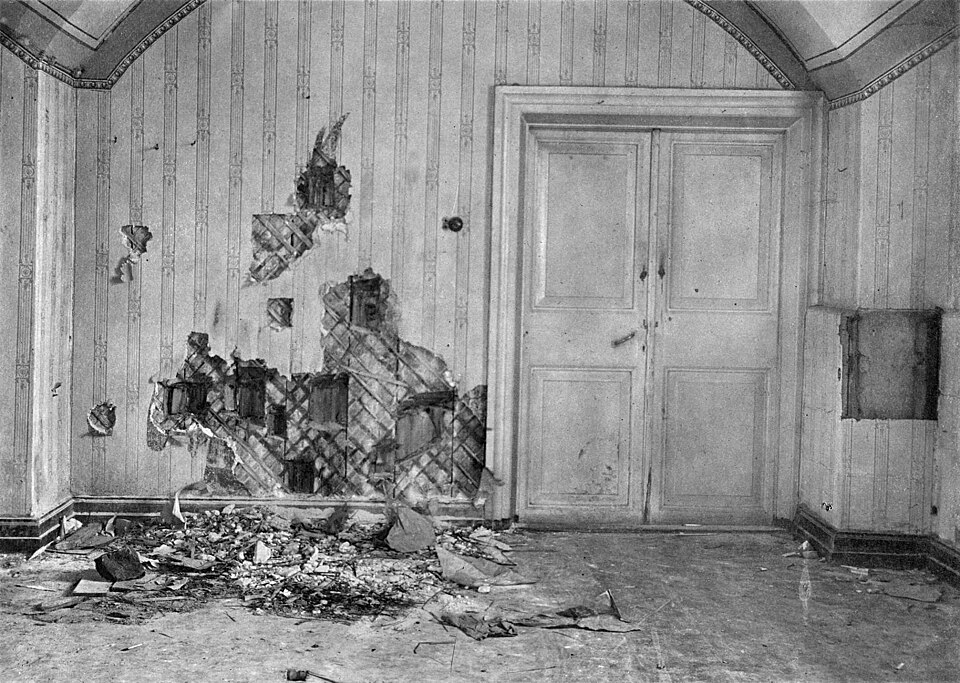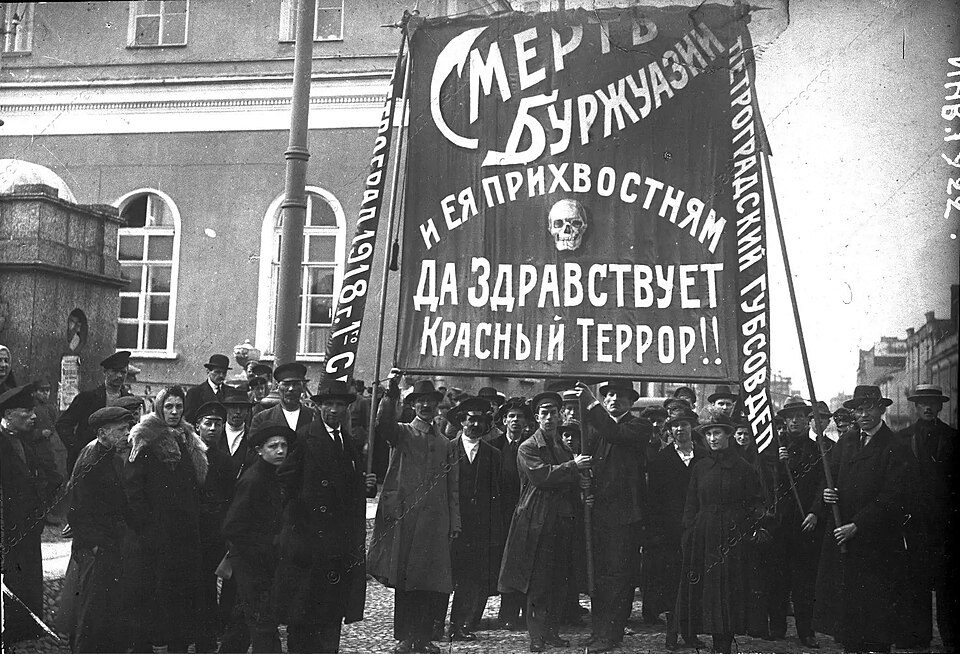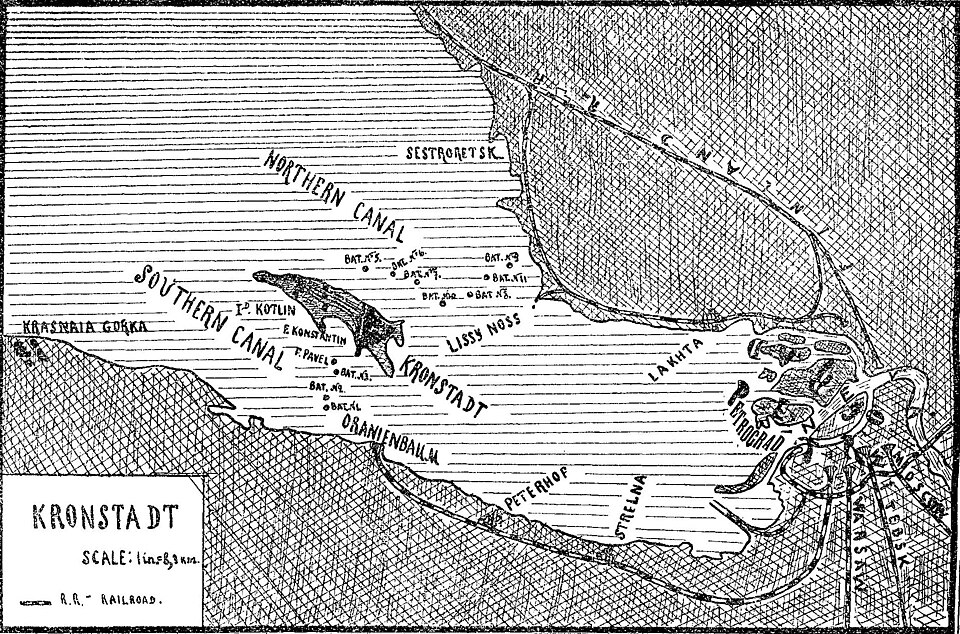OCR Specification focus:
‘murder of the Tsar; Red Terror, Kronstadt Rising’
The murder of the Romanovs and the subsequent Red Terror marked turning points in Bolshevik power, shaping revolutionary authority through violence, repression, and ideological justification.
The Murder of the Tsar and His Family
Background to the Execution
Following the abdication of Nicholas II in March 1917, the imperial family lived under arrest in Tobolsk before being transferred to Ekaterinburg in 1918. The advance of White armies in the Civil War raised Bolshevik fears that the Romanovs could be rescued and serve as a rallying point for counter-revolution.
Circumstances of the Murder
On 17 July 1918, Nicholas II, Alexandra, and their five children, along with four loyal servants, were executed by a Cheka firing squad.
The killings took place in the basement of the Ipatiev House, under the command of the local Bolshevik authorities, with approval from Moscow.
The murder was initially concealed; the Soviet government later admitted responsibility, justifying it as a necessary measure to prevent monarchist revival.
In the early hours of 17 July 1918, the Romanovs were assembled in the basement of the Ipatiev House and shot by a Cheka firing squad.

Basement room of the Ipatiev House in Ekaterinburg where Nicholas II and his family were executed in July 1918. The damaged wall reflects investigators’ later searches for bullets and evidence. A stark primary visual for the murder site. Source
Significance of the Romanov Murders
Symbolised the irreversibility of the revolution: with the Tsar dead, restoration of monarchy was impossible.
Demonstrated the Bolsheviks’ willingness to use violence against perceived enemies.
Provided propaganda ammunition to the Whites, who denounced Bolshevik barbarity.
Historians debate whether Lenin personally ordered the killings, but evidence suggests at least tacit approval.
The Red Terror
Definition and Origins
The Red Terror was the campaign of political repression, executions, and mass arrests carried out by the Bolsheviks from 1918 onwards, primarily by the Cheka.
Red Terror: A policy of mass repression and systematic violence, initiated by the Bolsheviks during the Civil War, targeting perceived political opponents, counter-revolutionaries, and class enemies.
It was partly triggered by:
The assassination attempt on Lenin in August 1918 by Fanya Kaplan.
The murder of Cheka leader Moisei Uritsky.
Rising resistance from Socialist Revolutionaries, Mensheviks, and peasant uprisings.
Following Uritsky’s murder and the attempt on Lenin, Bolshevik leaders announced a campaign of Red Terror targeting so-called ‘counter-revolutionary’ enemies and hostages.

Funeral of Moisei Uritsky, Petrograd, 2 September 1918. The banner proclaims “Death to the bourgeois and their helpers. Long live the Red Terror,” encapsulating the campaign’s punitive ideology. A concise primary source for Red Terror messaging. Source
Implementation
The Cheka, under Felix Dzerzhinsky, led the campaign. Measures included:
Mass executions of political prisoners and hostages.
Establishment of concentration camps.
Use of torture to extract confessions.
Summary justice without trial.
Aims of the Red Terror
To eliminate opposition and consolidate Bolshevik control.
To instil fear among the population and deter resistance.
To mobilise class hatred, portraying the struggle as proletariat vs. bourgeoisie.
Scale of Repression
Tens of thousands were executed between 1918 and 1921.
Victims included Socialist Revolutionaries, former Tsarist officials, clergy, peasants resisting grain requisitioning, and suspected Whites.
The policy became institutionalised, laying the foundation for later Stalinist purges.
The Kronstadt Rising
Background
The sailors at the Kronstadt naval base had been strong supporters of the October Revolution. However, by 1921, war communism and Cheka repression alienated even these revolutionary loyalists.
Causes of the Revolt
Severe food shortages due to grain requisitioning.
Harsh economic controls of war communism.
Opposition to Bolshevik suppression of other socialist parties.
Events of the Rising
In March 1921, Kronstadt sailors issued demands for “Soviets without Bolsheviks”, calling for political freedoms and economic reforms.
The Bolshevik government, fearing the revolt would spread, sent the Red Army under Trotsky to crush it.
After heavy fighting across the frozen Gulf of Finland, the rebellion was suppressed with great bloodshed.
In March 1921 the Kronstadt Rising on Kotlin Island was suppressed as Tukhachevsky’s forces crossed the ice from Petrograd to storm the fortress.

Hand-drawn map by Alexander Berkman showing Kronstadt, Kotlin Island, nearby forts, and the Gulf of Finland approaches. Useful for visualising rebel positions and the Red Army’s attack paths across the ice. Source
Consequences
Around 15,000 sailors were killed, imprisoned, or exiled.
The rising shocked the Bolsheviks, as former allies had turned against them.
The rebellion helped push Lenin towards the New Economic Policy (NEP) later in 1921, as a tactical retreat from the harshest policies of war communism.
Broader Implications
Consolidation of Bolshevik Power
The murder of the Tsar, the Red Terror, and the suppression of the Kronstadt Rising collectively demonstrated the Bolsheviks’ reliance on violence, fear, and repression to secure their rule. These actions discouraged opposition and established a precedent for authoritarian governance.
Legacy
The murder of the Romanovs ended any prospect of monarchist restoration.
The Red Terror entrenched a culture of political violence in Soviet governance.
The Kronstadt Rising highlighted the limits of repression, forcing tactical concessions but confirming the Bolsheviks’ unwillingness to tolerate dissent.
FAQ
The Bolsheviks feared international and domestic backlash if news of the killings spread immediately. Monarchist forces in the Civil War might have been galvanised to fight harder had they known the Tsar was gone.
By releasing vague or misleading reports, the regime bought time to frame the murders as a defensive act rather than a gratuitous massacre. Only later did the Bolsheviks openly justify the decision as a necessary step against counter-revolution.
Reactions were mixed but generally hostile. Britain and France condemned the killings as barbaric, using them to highlight Bolshevik brutality.
Some foreign monarchies, especially those related to the Romanovs, were personally horrified, while anti-Bolshevik propaganda in Europe frequently used the event as evidence of Soviet illegitimacy.
Public executions, sometimes staged in market squares, designed to intimidate entire communities.
Use of hostages, where relatives of alleged enemies were shot if resistance continued.
Establishment of labour camps for long-term punishment.
These measures communicated that disloyalty to the Bolsheviks would bring immediate and severe consequences, deterring widespread resistance.
Kronstadt sailors had been celebrated as the “pride and glory of the Revolution” for their role in 1917. Their rebellion in 1921 undermined the image of unanimous support among workers and soldiers.
If such loyal revolutionaries could turn against the regime, it suggested that Bolshevik policies were alienating even their most trusted allies. This made the revolt both symbolically and strategically dangerous.
The revolt revealed deep discontent with war communism, especially food requisitioning and political repression.
Lenin recognised that continued harsh policies risked further uprisings and possibly the collapse of Bolshevik control. The NEP was thus introduced as a tactical retreat, easing economic pressures while maintaining political dominance.
Practice Questions
Question 1 (2 marks)
In which year were Nicholas II and his family executed, and in which city did this take place?
Mark Scheme
1 mark for correct year: 1918
1 mark for correct city: Ekaterinburg
(Maximum 2 marks)
Question 2 (6 marks)
Explain two reasons why the Bolsheviks launched the Red Terror in 1918.
Mark Scheme
Up to 3 marks per reason.
1 mark for identifying a reason.
1–2 further marks for explanation showing understanding of context.
Indicative content:
The assassination attempt on Lenin in August 1918 created a climate of fear and a determination to destroy opposition.
The murder of Cheka leader Uritsky and wider threats from Socialist Revolutionaries and Mensheviks convinced the Bolsheviks of the need for repression.
The Civil War context: Bolsheviks feared counter-revolutionary activity and sought to eliminate class enemies such as the bourgeoisie.
Level of response:
1–2 marks: Simple statements with little development (e.g. “They wanted to stay in power”).
3–4 marks: Some explanation with limited detail (e.g. “Because Lenin was attacked, they feared for their survival”).
5–6 marks: Clear, developed explanation showing understanding of causes and context, with two distinct reasons fully explained.

